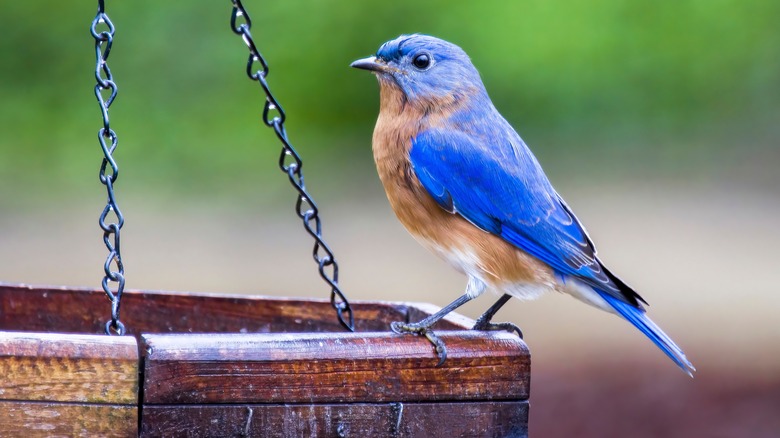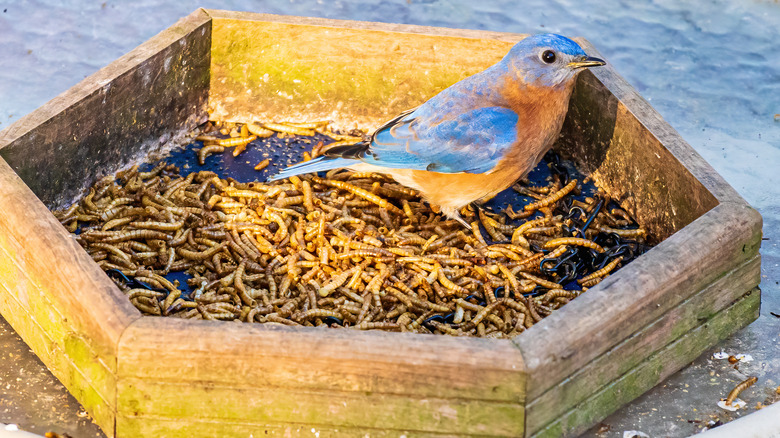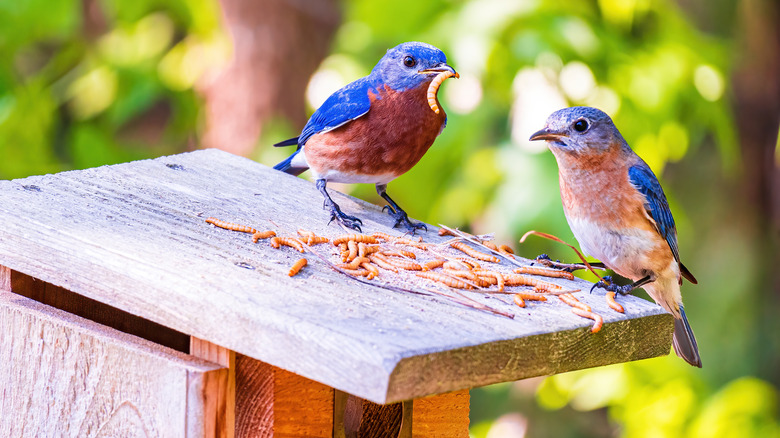Don't Make This Harmful Mistake When Feeding The Bluebirds In Your Garden
Whether you're an avian fanatic or a humble backyard birdwatcher, an eastern bluebird can be one of the most exciting birds to spot near your home. For those who like to attract birds to their yards with feeders, luring an eastern bluebird can be quite the challenge, so seeing one is all the more satisfying. Bluebirds are omnivores, dining on a variety of insects, berries, earthworms, and snails, but they rarely reach for nuts and birdseed, so it takes some special menu planning to bring them into your yard. Mealworms are an affordable and accessible option, but they could also be one of the mistakes you're making with your bird feeder. Unfortunately, mealworms (and crickets, for that matter) don't provide a good source of calcium — they're essentially bluebird candy. If your birds are frequently filling up on mealworms, they won't consume enough calcium, potentially leading to brittle eggshells, weakened bones, and unhealthy baby bluebirds.
If you want to enjoy watching bluebirds for generations to come, it's best to go easy on the mealworms. Plus, some mealworms are better to feed with than others, especially during the birds' nesting season. Here's why mealworms should be offered only as an occasional treat, and here are some tips for safely feeding mealworms to birds without risking their health.
Bluebirds shouldn't overfeed on mealworms
Bluebirds should consume calcium and phosphorous in a 2:1 ratio for healthy bones and eggshells. Mealworms contain some calcium but are extremely high in phosphorous, throwing off this delicate dietary balance. Because they have more built-up reserves of calcium in their bones, adult bluebirds may be able to handle mealworms as a treat as long as they get enough nutrients from other food sources. However, during the breeding and nesting season, it's especially important for bluebirds to consume enough calcium. A calcium deficiency can lead to a condition known as egg-binding, where the shell of a forming egg doesn't harden completely. Soft eggs aren't just an issue for the baby bird; they can also cause serious complications for the mother bird. A soft egg could become trapped inside the mother, leading to exhaustion, egg rupture, infection, and even death.
Assuming the eggs develop correctly, baby birds will also need that crucial calcium supply in their diets to keep growing strong bones, so never place mealworms in or near the nesting box. Mealworms have a tough exoskeleton that doesn't usually present an issue for adult birds but can be difficult for baby birds to break through and digest. Uneaten worms could attract ants that will harm the baby birds. When it comes to feeding their babies, the parents know best, so let them decide when the growing babies are ready for a mealworm snack.
Live mealworms are more appropriate as an off-season treat
If you have bluebirds in your yard, should you have your feeders out during the summer? A few mealworms a day can be okay during the spring and early summer breeding season, but you'll want to encourage parent birds to find more nutrient-dense foods for themselves and their offspring. Grow native berry plants like viburnum or offer sunflower hearts, safflower, and green caterpillars. To be on the safe side, wait to bring out mealworms until late summer, when baby birds have matured, and mother birds aren't likely to be pregnant. Dried mealworms offer less nutritional value and are more challenging for baby birds to digest. Although they can be more expensive, live mealworms are better, and the wriggling of live mealworms in a dish also makes them more attractive. Be sure to offer live mealworms in a container with sides so they won't wiggle away.
Supplementing with calcium can also make the mealworms a healthier snack! Put the mealworms in a plastic bag with a pulverized calcium source, such as ground oyster shells, ground egg shells, or powdered calcium carbonate, then gently shake the bag to cover the mealworms in a calcium coating. Offering the mealworms this way ensures that the birds get an extra helping of calcium with their candy. Besides offering these tasty treats, you can also explore other methods for how to attract bluebirds to your garden, such as providing birdhouses, perches, and water sources.


